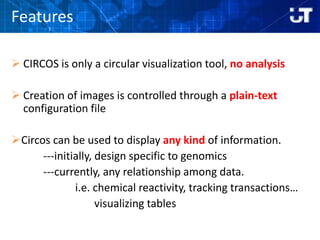Circos
- 1. Introduction of Circos Yunyun Zhou 03/11/2014
- 2. Introduction PRETTY Circular visualization POPULAR --- APPEARED IN A VARIETY OF PUBLICATIONS
- 4. Features ï CIRCOS is only a circular visualization tool, no analysis ï Creation of images is controlled through a plain-text configuration file ïCircos can be used to display any kind of information. ---initially, design specific to genomics ---currently, any relationship among data. i.e. chemical reactivity, tracking transactionsâĶ visualizing tables
- 5. Typical Circos Image (A) histogram (B) ideograms (C) histogram (D) heatmap (E) links (F) highlights (G) grid (H) ticks
- 6. CIRCOS installation 1. System requirement: Unix/Linux/Mac 2. Download & Install circos software 3. Install Required Perl modules 4. Download Tutorial (Best practice examples)
- 7. Plain Text Input Files > circos -conf etc/circos.conf
- 8. Configuration file (circos.conf) <ticks> <<include ../etc/ticks.conf>> <ticks> ticks.conf
- 9. Genome to Genome link
- 10. Clickable image âĒ Associate areas of the image with web links. âĒ Any element in the image (ideogram, tick, band, highlight, ribobn, etc) can have an associated URL. FEATURES: ï MAKING IDEOGRAMS CLICKABLE <ideogram> ideogram_url = http://www.google.com/search?q=[chr] âĶâĶ <ideogram> chr - hs1 1 0 247249719 chr1 url=special_script?chr=[chr] chr - hs2 2 0 242951149 chr2 url=another_special_script?chr=[chr] chr - hs3 3 0 199501827 chr3 ï DEFINING URLS SPECIFIC TO INDIVIDUAL IDEOGRAMS METHODS:
- 11. Image map
- 12. 1. Microbial Genome 2. Link Geometry - Detailed Bezier Control 3. Labeling Karyotype Bands 4. Image Maps 5. Image Transparency and Background 6. Manipulating Histograms 7. Variable Radius Link Ends 8. Stacked Histograms 9. Transparent Links 10. ID Fields 11. Heat Map Links 12. Inverted Links 13. Copy Number Data 14. Directed Links 15. Pattern Fills 16. Automating Tracks 17. Automating Heatmaps 18. Circular Stacked Bar Plots 19. Cortical Maps â Connectograms 20. Cell Cycle â Part 1 21. Cell Cycle â Part 2 22. Nature Cover Encode Diagram 23. Naming Names Recipes âĒ Configuration files âĒ Input data file âĒ Output images Provided files:
- 13. Copy number variation scatter plot chrom start end logFC hs3 7683536 8465787 1.43 hs11 465784 756867 -0.65 gc.txt
- 14. track for [0,3] CNV data range [-3,3] Different background for the positive and negative CNV values <plot> type = scatter file = data/8/13/data.cnv.txt r0 = 0.6r r1 = 0.75r min = -3 max = 0 glyph = circle glyph_size = 8 color = red <axes> <axis> color = lred thickness = 2 spacing = 0.1r </axis> </axes> <backgrounds> <background> color = vlred_a5 </background> </backgrounds> âĶ.. track for [-3,0] <plot> type = scatter file = data/8/13/data.cnv.txt r0 = 0.75r r1 = 0.9r min = 0 max = 3 glyph = circle glyph_size = 8 color = green <axes> <axis> color = lgreen thickness = 2 spacing = 0.1r </axis> </axes> <backgrounds> <background> color = vlred_a5 </background> </backgrounds> âĶ..
- 15. Visualizing Biological Data http://vizbi.org/ Genomic alignments Phylogenies macromolecular structures system biology









![Clickable image
âĒ Associate areas of the image with web links.
âĒ Any element in the image (ideogram, tick, band, highlight, ribobn, etc) can
have an associated URL.
FEATURES:
ï MAKING IDEOGRAMS CLICKABLE
<ideogram>
ideogram_url = http://www.google.com/search?q=[chr]
âĶâĶ
<ideogram>
chr - hs1 1 0 247249719 chr1 url=special_script?chr=[chr]
chr - hs2 2 0 242951149 chr2 url=another_special_script?chr=[chr]
chr - hs3 3 0 199501827 chr3
ï DEFINING URLS SPECIFIC TO INDIVIDUAL IDEOGRAMS
METHODS:](https://image.slidesharecdn.com/circos0311-140402155959-phpapp02/85/Circos-10-320.jpg)



![track for [0,3]
CNV data range [-3,3]
Different background for the positive and negative CNV values
<plot>
type = scatter
file = data/8/13/data.cnv.txt
r0 = 0.6r
r1 = 0.75r
min = -3
max = 0
glyph = circle
glyph_size = 8
color = red
<axes>
<axis>
color = lred
thickness = 2
spacing = 0.1r
</axis>
</axes>
<backgrounds>
<background>
color = vlred_a5
</background>
</backgrounds>
âĶ..
track for [-3,0]
<plot>
type = scatter
file = data/8/13/data.cnv.txt
r0 = 0.75r
r1 = 0.9r
min = 0
max = 3
glyph = circle
glyph_size = 8
color = green
<axes>
<axis>
color = lgreen
thickness = 2
spacing = 0.1r
</axis>
</axes>
<backgrounds>
<background>
color = vlred_a5
</background>
</backgrounds>
âĶ..](https://image.slidesharecdn.com/circos0311-140402155959-phpapp02/85/Circos-14-320.jpg)

